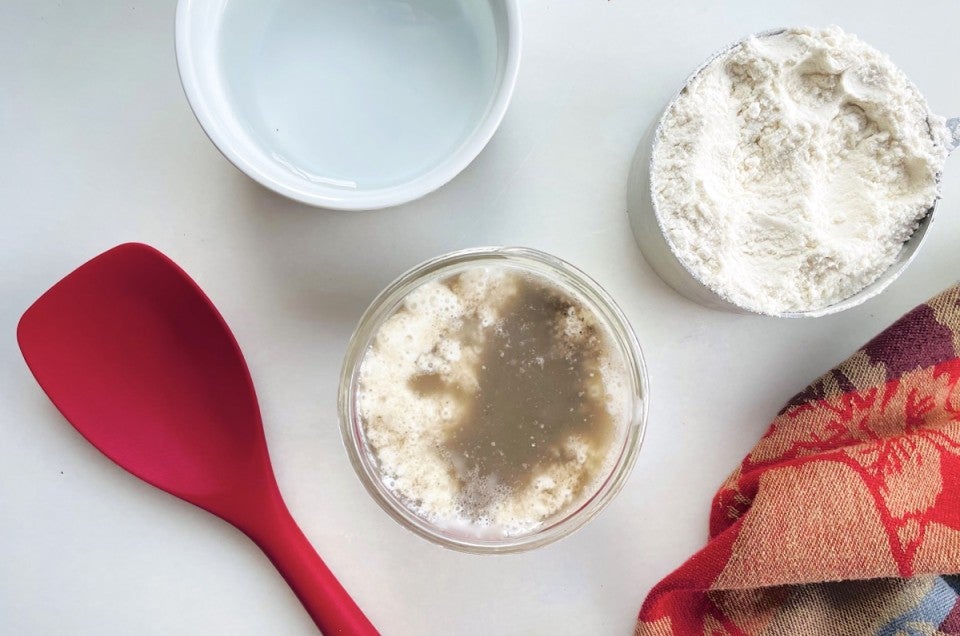Do you think you killed your sourdough starter?
Your starter hasn’t been fed in months and looks awful, but it’s OK — really.


 Love sourdough, but looking for a bit more flexibility and ease when you bake with a starter? In The Casual Sourdough Baker, PJ shows you just how wonderfully stress-free sourdough baking can be, from simple but richly flavored loaves to countless easy ways to use your discard. If you're just beginning your journey, our Sourdough Baking Guide lays out the basics you need for success — whether you decide to become serious or go casual!
Love sourdough, but looking for a bit more flexibility and ease when you bake with a starter? In The Casual Sourdough Baker, PJ shows you just how wonderfully stress-free sourdough baking can be, from simple but richly flavored loaves to countless easy ways to use your discard. If you're just beginning your journey, our Sourdough Baking Guide lays out the basics you need for success — whether you decide to become serious or go casual!
* * *
“I think I killed my starter.”
How many millions of sourdough bakers have uttered those devastating words? The starter you coaxed to life, watched grow, then used to bake many delectable loaves — dead. And all because you stashed it in the back of the fridge and forgot to feed it for a few weeks (or maybe even months).
In reality, it’s very difficult to kill sourdough starter — especially through benign neglect. Yes, you can put fed starter in your turned-off oven to stay warm, forget about it, and preheat the oven to 450°F for biscuits. Whoops — killed it.
Or your partner sees what looks like an ancient jar of leftover pancake batter in the back of the fridge and drains your starter down the sink. OK, done.
There’s even the very, very remote possibility your starter becomes infected with bad bacteria or mold, turns pinkish, and smells acrid: time to say goodbye.
But simply forgetting to feed your starter? Hey, that’s not going to kill it; it’s just taking a very long nap. And like Sleeping Beauty, the Prince’s kiss (in this case, flour and water) will bring it back to life.
Your starter will be happiest and healthiest if you feed it twice a day (if it lives on the counter), or once a week if it’s stored in the refrigerator. (If you keep your starter on the counter full time, then you’re probably not forgetting to feed it; so going forward, I’m going to assume you store your starter in the fridge.)
After a week without food, your starter probably has a thin layer of clear to light-amber liquid on its surface. This is alcohol, a byproduct of fermentation (a.k.a. hooch), and is perfectly fine to stir back into the starter.
The hooch atop your starter has grown a bit darker in color. This is a sign the starter has ramped down its activity; the alcohol is old and oxidizing. If you feed your starter at this point, either stir in the hooch or pour it off; it doesn’t matter either way (though it may temporarily turn your starter a bit gray in color).
The layer of hooch on your starter will have gotten darker (almost black); or it may even have dried up and formed a dark gray, corrugated “skin.” While this looks awful, it’s really not; simply peel off (and discard) the skin and you’ll find your liquid, cream-colored (albeit very hungry) starter underneath.
If you weren’t storing much starter to begin with, it may simply have dried up entirely and turned into a darkish chalk-like block. You can try to revive it by pulverizing it and adding water, then feeding it on a regular schedule. But if it doesn’t respond at all (no growth, no bubbles) after three or four days of twice-a-day feedings, you might as well start over. Just be sure to stir some of your old starter into the new — so you can continue to brag about how long you’ve kept your starter going!
Remember: If your starter has a weird color other than in its hooch (or skin) on top — anything beyond cream/amber, in the pink/blue/green/orange spectrum — throw it out. Ditto if it smells off-putting: not just strongly of alcohol or vinegar or even mildly of nail-polish remover, but bad; like, ewww, don’t eat this.
To revive your neglected starter, stir in any hooch (or drain it off, your choice). Measure 113g (about 1/2 cup, about 4 ounces) into a small mixing bowl. Discard the remainder; it’s probably old enough that you won’t want to bake anything with it.
Feed the 113g saved starter with equal parts (by weight) unbleached all-purpose flour (56g) and water (56g). Usually, you’d feed with cool or room temperature water. But since your starter has been in the fridge, warm (not hot) tap water will help get things going.
Stir thoroughly, and transfer the mixture to a clear, straight-sided container; a large (32-ounce) glass pickle or olive jar, the kind you’d get at a club store, is ideal, as is a 2-pint wide-mouth mason jar. Add the jar lid, but don’t screw it down tight.
Loop a rubber band around the jar at the level of the starter. Measure the height of your starter and add another rubber band to the jar at double the starter’s current height. This will allow you to measure the starter’s activity level.
A room temperature of 75°F to 78°F is ideal. But if it’s cooler, no worries; your starter will simply come to life more slowly. And if it’s summer, and warmer? Your starter will wake up more quickly than it might have.
After 12 hours has your starter inched up the jar at all? Is it showing any bubbles — either on its surface or underneath? If so, yes! It’s alive.
At this point you can return your starter to the refrigerator with a renewed vow to feed it every week. But to really bring your starter back to its normal healthy self, continue the feeding process until it doubles in size within 12 hours. This might take another couple of feedings (or several days’ worth), but it’s time and flour well spent.
If after that initial 12 hours your starter looks exactly or nearly the same as it did when it started (no growth, few bubbles) — no worries! Repeat the feeding process (discard, feed) and check it again in 12 hours. Still no activity? Repeat. The longer you’ve let it linger unfed in the fridge, the more time it’ll take to wake up. But eventually it should start to bubble and grow.
Finally, just because you’ve pulled your starter back from the brink doesn’t mean you’re ready to bake a big crusty loaf of naturally leavened bread: Your starter won’t be ready to raise bread on its own (without the added boost of commercial yeast) until it’s doubling in size within six to eight hours of having been fed.
You won’t want to keep the starter you initially discard (it’s probably kind of gnarly), but the discard from subsequent feedings can be used to make all manner of tasty treats; Sourdough Crumpets are a big favorite at my house. If you're not going to use the discard immediately, store it in the fridge.
So what happens if your starter really did die? Begin again with a jar of our fresh sourdough starter, which can have you up and baking within 24 hours of receiving it.